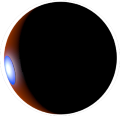The impact crater’s properties depend critically on knowledge of impactor and target site. That knowledge must be very coarse at present. More impactor knowledge will be acquired by the Shepherd en route. More target knowledge will be acquired from orbit, and preferably in situ by an early crewed expedition. Meanwhile most Omaha Crater numbers are ballpark.
Impact Crater
The final crater is 9 km in diameter and more than 1 km deep, as measured from the pre-impact surface. The impact occurs at an angle sufficient to prevent shearing rebound of the body. Also the impact is customized by NDA methods to produce a deeper, larger crater than would normally be predicted. High impact angle and over-deepening maximize the heated impactor mass captured in bedrock. 1018 Joules is a conservative estimate of the sensible heat injected into a bedrock heat lens. Diameter of lens is 3.3 km. The lens is aligned with crater center, 1.5 km thick. It thins radially outward, and upward toward the exposed bedrock surface at lens perimeter. The volume of thawed bedrock is at least 10 km3. Most of the heat lens is covered by impact rebound debris having maximum depth of about 1 km.
Models do not presently capture the full range of temperatures observed in fresh impact craters. For example, terrestrial Lonar Crater contains alteration minerals indicating heat lens temperatures exceeding 130 °C, lasting long enough at least to produce the observed minerals. A 40 °C maximum temperature would be a more typical model prediction. The higher temperatures might occur only in isolated hot-spots, but should be expected in Omaha Crater. It is 9 km in diameter, whereas Lonar Crater is only 1.2 km. These hot-spots would not be hot enough to produce useful geothermal power, but they could serve as high-temperature heat exchangers – especially useful for high-efficiency water electrolysis.
Cryosphere
Impact vapor and upland periglacial water harvest initiate reservoir fill. Persistent groundwater flux also contributes to the fill, with flux likely exceeding 10-6 kg/m2s initially, and decreasing over several thousand years as the crater drains and freezes inward.
Around and beneath the groundwater and heat lens is a persistent cryosphere. It’s an open question as to whether the Omaha Crater heat lens penetrates the cryosphere. The likelihood depends on geothermal heat flux at the target site and the depth of impact penetration. Notably, impact fracturing can extend a km beneath the heat lens.
Thawing or fracturing of the cryosphere base would admit a hypothetical closed aquifer into the crater bedrock and potentially the surface water bodies. The existence of a closed aquifer is unknown, but given the widespread regional evidence of ice, a closed aquifer should be considered. Aquifer melt-through would transit the heat lens under pressure, boiling out as it rises. Permeability of the lens bedrock is unknown, but if it exceeds 10-10 m2 the lens will also actively convect water (pressurized or not) from below. Much steam recondenses near the surface. This water and any convected or drained groundwater accumulates in a km+ engineered central depression, which serves first as a protective retention basin. Excess water is removed as needed through forced evaporation, borehole boil-off, or other methods.
Lake Matthew
If debris cover is sufficiently thick to insulate the heat lens, the central depression can serve as Lake Matthew. If the heat lens is not well covered and insulated, and excess boil-off occurs, an alternate depression is selected for Lake Matthew. The heat lens averages 50 °C at its buried center, with bedrock temperature declining toward the perimeter and up toward the surface, passing 0 °C at radius of 1.7 km. Strings of reservoir depressions having adjustable diameter and depth are arranged radially to 3 km, all by NDA methods. In this way at least one depression surface is guaranteed to intersect the heat lens near its 0 °C radius. This is the optimal location for Lake Matthew, where minimum energy is needed to maintain bulk water temperature between 0 °C and 11 °C, the local boiling point.
11 °C is only the surface boiling point. Boiling point increases with depth, rising to room-temperature at 1 m depth. This allows for room-temperature water in the lake and in dome coverage ponds, so long as a meter of ice covers the surface. But for simplicity and energy efficiency, 11 °C is the nominal maximum near-surface water temperature.
Reservoirs
Industrial water treatment such as Zero Liquid Discharge (ZLD) must separate salts from the lakewater, resulting in brine production. Salts increase boiling point and lower freezing point. For example, increasing molarity of calcium chloride brine by 1 M lowers freezing point from -20 °C to -40 °C. Therefore brine reservoirs for various purposes can persist with little active management, in depressions that have a broader bedrock temperature range than acceptable for Lake Matthew.
Habs
Habs and greenhouses are situated in depressions having bedrock above 0 °C. Hab freshwater is admitted hot from the treatment plant’s heat exchanger. It radiates heat within the domes to counter the domes’ heat loss to icy greywater circulated above. A combination of closed heat exchange loops and open flows manage facility temperature with little electrical power. For example, heating a 300 m dome with 50 °C water 18 hr/sol, with 200 m head and dome U value of 1 W/m2K, requires only about 12 liters of water per second, lifted by a 7 kW pump.
Contact: LakeMatthewTeam@gmail.com
